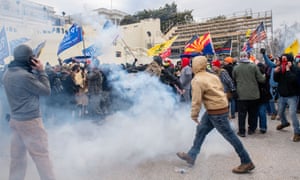A return to civility will not begin to quell the threat of fascism in the US
Richard SeymourThe storming of the Capitol shows that the groundwork is in place for a far-right movement that outlasts Trump
‘Serious questions need to be asked about how an armed mob was able to “storm” the Capitol building in the first place.’ Photograph: Amy Harris/Rex/Shutterstock
What was this desperado putsch supposed to achieve? The mob of face-painted LARPers, QAnon conspiracists, militiamen, neo-Nazis, Christian supremacists and endtimes preppers who invaded the Capitol building in Washington DC were never going to overturn the results of the 2020 presidential election.
And yet they are far from a few isolated cranks. This crowd, whose actions are supported by 45% of Republican voters, had been called to the capital by Donald Trump. Their “protest” had been incited from the podium by both Trump and Rudi Giuliani, ramming home their betrayal myth that the election was stolen. Trump’s campaign to reverse the election results and subvert constitutional law, backed by several elected Republican officials, has repeatedly inspired violence. Trump has repeatedly backed the militias, from his bellowing approval of their anti-lockdown stunts to his support for vigilante violence against Black Lives Matter protesters, to his call for militia action on election day.
While Trump had been kept under control by the Republican establishment for most of his tenure, the last year – since the lockdown protests began – saw a process of radicalisation of the armed base, the administration and its white suburban supporters. The further the extra-parliamentary right went, the more violent it became, the further Trump went. Any violent exhortation was justified by a hallucinatory anti-communism. What’s more, there has emerged a set of tacit alliances between law enforcement and armed vigilantes, as seen in the Black Lives Matter protests.
Advertisement
Reporting and inquiries will shed light on what happened in the coming weeks, but serious questions need to be asked about how an armed mob was able to “storm” the Capitol building in the first place, wandering corridors to take selfies with cops, exploring computer screens left unmanned by hastily-evacuated staff and hunting for elected officials to confront. It stretches credulity to think they could have taken over the debating chamber, even after what appears to have been a tense armed standoff, without some kind of orchestrated or de facto acquiescence. Their braying triumphalism after they were evicted, claiming victory, glossed over both this and the extraordinarily delayed arrival of the National Guard.
This is all indicative of an incipient fascism, laying the cultural and political groundwork for a violent, extra-parliamentary mass movement of the right. It is a mistake to assume that fascism must take the form of dictatorship. Far-right movements today are shaped by the same factors: the decomposition of parliamentary legitimacy and their inherited organisational weaknesses. In that context, wielding the power of office is a pedagogical, formative experience. It allows movements with thin civic roots to project influence at a national level and try things out.
Fascism does not arrive on the scene with full uniform and programme. The Jewish socialist Arthur Rosenberg traced the origins of fascism as a mass movement to the period before the first world war, when millions were already infected by volkisch, racial-nationalist ideology, and by contempt for democratic government. It consolidates through experimentation, learning the ropes through episodes that, at first, appear amateurish and thuggish, from the beer hall (Munich) putsch to the demolition of the Babri Masjid. First as farce, then as tragedy.
There has been, for some time, accumulating data suggestive of a political rupture on the right. The growing number of people, particularly among the rich, who favour some form of authoritarian government, is one sign. The string of popularly elected, and often re-elected, rightist governments militantly challenging liberal legal norms and institutions is another. The rise of lone-wolf murderers and conspiracist vigilantes is yet another. And there is the proliferation of militias and paramilitaries, often with close relationships to police and the military rank and file. As the contemporary historian Kathleen Belew’s work has demonstrated, many white-power and fascist currents were forged in the furnace of war.
In the United States, the rupture has been building since before the Tea Party movement. During the 2008 election, paranoid racists brought guns and nooses to town hall meetings and called Obama a Muslim, the birth of the “birther” myth. It points to either a split in the Republican party or its complete capture by middle-class enragés. This is a grievous problem for ruthless GOP establishment operators such as Senators Mitch McConnell and Lindsey Graham, who spent years defending the Trump administration, using him to consolidate their electoral base, strengthen a minoritarian grip on government and take over the courts. Their traditional allies, including the National Association of Manufacturers, are not prepared to countenance a party this out of control – but they can’t simply throw away half of the Republican vote.
And this is their problem. Trumpism is not an aberration, but a mass phenomenon. Trump greatly expanded his base between 2016 and 2020, adding more than 10 million votes to its total. He expanded into places and demographic constituencies thought to be closed to him. No other Republican presidential candidate could have done this. And it was achieved precisely through the same means that led to the spectacle in the Capitol. To hope that Joe Biden can defuse this by restoring civility and bipartisanship to Washington would be unforgivably complacent. The United States, and not just the United States, urgently needs an anti-fascist movement. We have not begun to see the end of this.
Richard Seymour is a political activist and author; his latest book is The Twittering Machine
Above is from: https://www.theguardian.com/commentisfree/2021/jan/08/threat-fascism-us-storming-capitol-far-right-trump

No comments:
Post a Comment